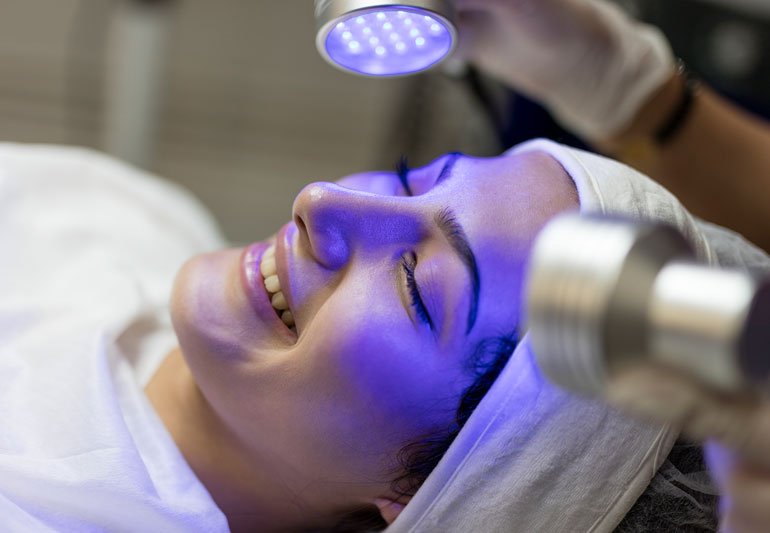

Blue light from electronic devices gets a bad rap for straining eyes and disrupting sleep. But this natural wavelength of light isn’t all bad.
Blue light therapy can help clear up acne and treat sun damage and non-melanoma skin cancers. Dermatologist Paul X. Benedetto, MD, explains how it works and who can benefit from feeling blue.
Blue light treatment for skin cancer
Blue light treatment is most often used as part of a treatment called photodynamic therapy. This therapy can treat some kinds of skin cancer and precancerous spots known as actinic keratoses. These reddish, scaly patches are caused by severe sun damage. Over time, they can turn into squamous cell carcinoma, a type of skin cancer.
To treat cancerous or precancerous spots with phototherapy, a dermatologist first applies a photosensitizing medication to your skin. “That makes the treated area sensitive to damage by the light,” Dr. Benedetto explains.
After letting the drug soak into your skin for an hour or two, the dermatologist shines blue light onto the treated skin for about 15 minutes. The light kills the cells that absorbed the sensitizing medication. Following the treatment, the damaged skin flakes off, leaving healthier, younger-looking skin behind.
For the best results, Dr. Benedetto says you’ll probably need to repeat the treatment two or three times, about four to six weeks apart.
“Photodynamic therapy can be really helpful for treating people who have a lot of sun damage or pre-cancers. Besides reducing the chances of developing skin cancer, it improves the appearance of the skin,” he adds.
Blue light acne treatment
Blue light can also spell lights out for some types of acne. Many cases of common acne are caused by a bacterium called Propionibacterium acnes, or P. acnes, which lives on your skin. And P. acnes just so happens to emit its own photosensitizer, which makes it sensitive to blue wavelengths of light.
Shining blue light onto acne-prone skin can kill the bacteria and clear up blemishes. But it’s not magic.
Blue light therapy doesn’t work for everyone, and it might take several sessions to find out if your acne is sensitive to blue light. If it is, you might still need to use other acne treatments, like prescription creams. But for some people, the treatment can light the way to clearer skin.
Can I use blue light therapy at home?
It’s possible to buy blue light devices to treat acne at home. But they may not be worth the investment. “I’d recommend having a dermatologist do it,” Dr. Benedetto says.
And because not everyone’s acne responds to blue light, purchasing a device might be a waste of time and money. Dermatologists can steer you toward the acne treatments that are most likely to work for you. If blue light is a good option, the devices in the doctor’s office are more powerful than those you can buy for at-home use.
Photodynamic therapy side effects
Blue light therapy is safe for most people, though it isn’t recommended for people with photosensitivity disorders (diseases that cause sensitivity to the sun).
When they’re used to treat acne, blue light treatments have few side effects, though some people might notice redness or dry skin.
However, blue light does have some side effects when it’s used with a photosensitizer as part of photodynamic therapy for skin cancer or sun damage:
- Irritation: After treatment, your skin will probably be red and may feel slightly burned, like a sunburn. “You can apply a cool compress and use gentle moisturizing creams to help with the discomfort,” Dr. Benedetto advises.
- Sun sensitivity: Your skin will be more sensitive to sunlight for two or three days, so skip the beach and rock your biggest hat. “It’s important to be really good about using sunscreen,” Dr. Benedetto says.
- Peeling: Over the next week or so, the treated areas will flake or crust over, then peel away. You might feel a little like a lizard, but that peeling is a good thing: It leaves behind fresher, healthier skin.
For patients with many years of sun damage, blue light can be a great tool for reducing skin cancer risk and improving the look of your skin — and that should leave you feeling anything but blue.
more recommended stories
 Safer Allogeneic Stem Cell Transplants with Treg Therapy
Safer Allogeneic Stem Cell Transplants with Treg TherapyA new preclinical study from the.
 AI in Emergency Medicine and Clinician Decision Accuracy
AI in Emergency Medicine and Clinician Decision AccuracyEmergency teams rely on rapid, accurate.
 Innovative AI Boosts Epilepsy Seizure Prediction by 44%
Innovative AI Boosts Epilepsy Seizure Prediction by 44%Transforming Seizure Prediction in Epilepsy Seizure.
 Hypnosis Boosts NIV Tolerance in Respiratory Failure
Hypnosis Boosts NIV Tolerance in Respiratory FailureA New Approach: Hypnosis Improves NIV.
 Bee-Sting Microneedle Patch for Painless Drug Delivery
Bee-Sting Microneedle Patch for Painless Drug DeliveryMicroneedle Patch: A Pain-Free Alternative for.
 AI Reshapes Anticoagulation in Atrial Fibrillation Care
AI Reshapes Anticoagulation in Atrial Fibrillation CareUnderstanding the Challenge of Atrial Fibrillation.
 Hemoglobin as Brain Antioxidant in Neurodegenerative Disease
Hemoglobin as Brain Antioxidant in Neurodegenerative DiseaseUncovering the Brain’s Own Defense Against.
 Global Data Resource for Progressive MS Research (Multiple Sclerosis)
Global Data Resource for Progressive MS Research (Multiple Sclerosis)The International Progressive MS Alliance has.
 AI Diabetes Risk Detection: Early T2D Prediction
AI Diabetes Risk Detection: Early T2D PredictionA new frontier in early diabetes.
 Cancer Cells Learn to Self-Report: A New Frontier in Immunotherapy
Cancer Cells Learn to Self-Report: A New Frontier in ImmunotherapyHow a Drug Complex Enables Immune.

Leave a Comment